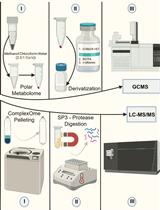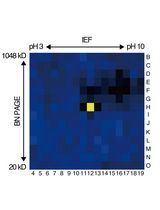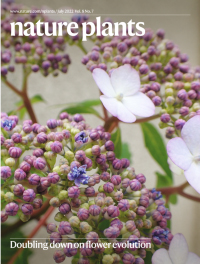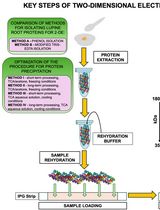- EN - English
- CN - 中文
A Simple Sonication Method to Isolate the Chloroplast Lumen in Arabidopsis thaliana
一种分离拟南芥叶绿体内腔的简单超声方法
发布: 2023年08月05日第13卷第15期 DOI: 10.21769/BioProtoc.4756 浏览次数: 2061
评审: Aswad KhadilkarSam-Geun KongAnonymous reviewer(s)

相关实验方案

利用SP3珠和稳定同位素质谱技术优化蛋白质合成速率:植物核糖体的案例研究
Dione Gentry-Torfer [...] Federico Martinez-Seidel
2024年05月05日 2627 阅读

基于活性蛋白质组学和二维聚丙烯酰胺凝胶电泳(2D-PAGE)鉴定拟南芥细胞间隙液中的靶蛋白酶
Sayaka Matsui and Yoshikatsu Matsubayashi
2025年03月05日 1732 阅读
Abstract
The chloroplast lumen contains at least 80 proteins whose function and regulation are not yet fully understood. Isolating the chloroplast lumen enables the characterization of the lumenal proteins. The lumen can be isolated in several ways through thylakoid disruption using a Yeda press or sonication, or through thylakoid solubilization using a detergent. Here, we present a simple procedure to isolate thylakoid lumen by sonication using leaves of the plant Arabidopsis thaliana. The step-by-step procedure is as follows: thylakoids are isolated from chloroplasts, loosely associated thylakoid surface proteins from the stroma are removed, and the lumen fraction is collected in the supernatant following sonication and centrifugation. Compared to other procedures, this method is easy to implement and saves time, plant material, and cost. Lumenal proteins are obtained in high quantity and purity; however, some stromal membrane–associated proteins are released to the lumen fraction, so this method could be further adapted if needed by decreasing sonication power and/or time.
Keywords: Thylakoid lumen (类囊体腔)Background
The chloroplast is the organelle that conducts photosynthesis in plants and algae. A major compartment of the chloroplast is the thylakoid lumen, which is enclosed by the thylakoid membrane. The Arabidopsis lumen proteome consists of at least 80 proteins based on mass spectrometry analyses (Peltier et al., 2002; Schubert et al., 2002) and up to 127 proteins according to lumenal targeting peptide prediction (Almagro Armenteros et al., 2019). All lumenal proteins characterized so far are nuclear-encoded and post-translationally transported into chloroplasts [see for reviews on lumenal proteins targeting (Albiniak et al., 2012) and function (Kieselbach and Schröder, 2003; Järvi et al., 2013)]. Lumenal proteins support and modulate photosynthetic activity directly or indirectly (examples of proteins are given in parenthesis), with known function in electron transport (plastocyanin PC, photosystem I subunit PsaN, and photosystem II subunit PsbO), in protein processing (C-terminal processing protease ctpA), assembly (immunophilins), and degradation (Deg proteases), in redox regulation (membrane protein with lumen thioredoxin domain HCF164) and in photoprotection (violaxanthin de-epoxidase and lipocalin in the plastid LCNP). However, the function of several lumenal proteins remains to be elucidated (some of which are Psb-like and pentapeptide repeat-containing proteins) and their regulation is not fully understood. The activity, stability, and distribution in the lumen compartment as soluble or membrane-associated proteins, or protein–protein interactions can be regulated by post-translational modifications such as phosphorylation or N-terminal acetylation (Gollan et al., 2021), or through redox modification or disulfide bond modulation, e.g., by lumen thiol oxidoreductase 1 of the lumenal domain of the kinase STN7 (Wu et al., 2021; for reviews, see Buchanan and Luan, 2005; Kang and Wang, 2016).
The major challenge when performing studies on the lumen proteome is the balance between purity and the quantity of protein needed for further analysis. Indeed, lumenal proteins are lowly abundant compared to thylakoid membrane protein light harvesting complex LHCII and stromal Rubisco [which represent more than 50% of total chloroplast protein content (Hall et al., 2011)]. Fractionation of the chloroplast and isolation of lumenal proteins thus enable their detection and accurate quantification by working within the dynamic range of detection, for example in immunoblot assays (the dynamic range is the lowest to highest concentration of a given protein that can be reliably detected). Then, the accumulation of a protein of interest can be investigated in different growth conditions or stress treatments and in mutants; the lumen proteome has been analyzed from 6–8-week-old plants grown under standard growth conditions (i.e., 120 μmol photons m-2·s-1, 21 °C, 8:16 h light/dark) (Peltier et al., 2002; Schubert et al., 2002) and also comparing the end of the dark vs. light period (Granlund et al., 2009) or after cold acclimation (Goulas et al., 2006). In addition, localization and distribution of the proteins, as well as assessment of protein complexes and interaction, can be inferred. Recently, Gollan et al. (2021) refined further localization studies to distinguish free lumenal proteins from membrane-associated ones, using Yeda press to isolate soluble lumenal proteins and subsequent washes with urea and salt to release inner membrane-associated proteins.
To isolate lumen proteins from plants, first the chloroplasts are obtained by homogenization of leaves followed by centrifugation; then, chloroplasts are lysed by osmotic shock, and thylakoid membranes are collected by centrifugation and washed to remove stromal proteins and peripheral membrane proteins. Finally, thylakoid membranes are ruptured to release lumenal proteins with a Yeda press (Kieselbach et al., 1998) or a sonicator (Peltier et al., 2000; Levesque-Tremblay et al., 2009); alternatively, thylakoid membranes are solubilized to release lumenal proteins using a detergent such as Triton X-114 followed by phase partitioning at 30–37 °C (Bricker et al., 2001), 0.04% Triton X-100 (McKinnon et al., 2020), or 0.05% n-Dodecyl β-D-maltoside (Chang et al., 2021).
Here, we report a simple procedure by which a lumenal fraction can be isolated in pure form from the thylakoids in Arabidopsis by sonication, which we adapted from previously described methods (Peltier et al., 2000; Levesque-Tremblay et al., 2009). Lumen isolation by sonication is of interest for several reasons: 1) the Yeda press is no longer commercially available (Hall et al., 2011), so unless already existing in the laboratory, access to one is limiting; 2) operating a sonicator is easier and faster than using the Yeda press for more than two samples (due to faster washing time of instruments parts); and 3) use of detergent can be costly and can disrupt native interactions. Also, the yield with sonication is comparable to using the Yeda press (15–30 μg of lumenal proteins per gram of leaf) and a decreased isolation time (from six to three hours for two samples) is valuable to limit proteolysis and preserve more native states of proteins and complexes during the lumen isolation. All methods present the disadvantage of stromal membrane–associated protein contaminants in the lumenal fraction that are not removed during the washes of thylakoid membranes (Bricker et al., 2001) (for example, see Figure 2, ATPb); the presence of these contaminants could be decreased by using a shorter sonication time and/or decreased power (Peltier et al., 2000). Overall, the sonication method is easy to implement, saves time, plant material, and cost, and is suitable for most studies—unless a large quantity of proteins is required, in which case the Yeda press method should be favored.
Materials and reagents
1.5 mL microcentrifuge tube (Sigma-Aldrich, catalog number: HS4323)
15 mL centrifuge tube (Thermo Fisher Scientific, catalog number: 339650)
Amicon ultra-0.5 centrifugal filter unit (EMD Millipore, catalog number: UFC500324)
10.4 mL polycarbonate bottle with cap assembly (Beckman Coulter, catalog number: 355603)
50 mL open-top thick-wall polycarbonate tube (Beckman Coulter, catalog number: 363647)
10 μL pipette tip (Thermo Fisher Scientific, catalog number: 3521-HR)
200 μL pipette tip (Thermo Fisher Scientific, catalog number: 3551-HR)
1,000 μL pipette tip (Thermo Fisher Scientific, catalog number: 3101-HR)
Disposable glass Pasteur pipettes 230 mm (VWR, catalog number: 612-1702)
1,000 mL plastic bag (e.g., Tingstad, catalog number: 398301-1)
Glass funnel (e.g., Sagitta, catalog number: 87807)
250 mL flask (e.g., Sagitta, catalog number: 86425)
25 mL beaker (e.g., VWR, catalog number: 213-0192)
Cuvette for chlorophyll quantification [e.g., Hellma, catalog number: HL104-002-10-40 (quartz, preferred) or Sarstedt, catalog number: 67.742 (plastic; ensure to measure right away so acetone does not degrade plastic and affect spectrophotometer reading)]
Paintbrush 6 mm (Ahlsell, catalog number: 384364)
Miracloth 22–25 μm pore size (Calbiochem, catalog number: 475855)
Arabidopsis thaliana plants (wild type and soq1-1 mutant, ecotype: Columbia-0)
Milli-Q water
2-Mercaptoethanol (Thermo Fisher Scientific, catalog number: 21985023)
Glycerol (Sigma-Aldrich, catalog number: G5516)
Bromophenol blue (Sigma-Aldrich, catalog number: B0126)
Ethanol (Sigma-Aldrich, catalog number: EX0290)
Acetic acid (Sigma-Aldrich, catalog number: 695092)
Coomassie blue R-250 (Sigma-Aldrich, catalog number: 1.12553)
Tris(hydroxymethyl)aminomethane (Tris base) (Sigma-Aldrich, catalog number: 648310-M)
Glycine (Sigma-Aldrich, catalog number: G8898)
Sodium dodecyl sulfate (SDS) (Sigma-Aldrich, catalog number: L3771)
Tween 20 (Sigma-Aldrich, catalog number: P9416)
Non-fat dried milk (e.g., Semper)
Tricine (Sigma-Aldrich, catalog number: T0377)
D-sorbitol (Sigma-Aldrich, catalog number: S1876)
Ethylenediaminetetraacetic acid (EDTA) (Sigma-Aldrich, catalog number: E9884)
Potassium chloride (KCl) (Sigma-Aldrich, catalog number: 529552)
Sodium L-ascorbate (Sigma-Aldrich, catalog number: A4034)
L-cysteine (Sigma-Aldrich, catalog number: C7352)
Sodium fluoride (Sigma-Aldrich, catalog number: 215309)
MgCl2 (Sigma-Aldrich, catalog number: M2670)
Concentrated HCl (37%) (Sigma-Aldrich, catalog number: 320331)
Disodium hydrogen phosphate (Na2HPO4) (Sigma-Aldrich, catalog number: 567550)
Sodium dihydrogen phosphate (NaH2PO4) (Sigma-Aldrich, catalog number: 1.06370)
Benzamidine (Sigma-Aldrich, catalog number: 12072)
ϵ-Aminocaproic acid (Sigma-Aldrich, catalog number: A2504)
Phenylmethanesulfonyl fluoride solution (PMSF) (Sigma-Aldrich, catalog number: 93482)
cOmpleteTM, EDTA-free protease inhibitor cocktail (Roche, catalog number: 4693132001)
Quick StartTM Bradford Protein Assay kit (Bio-Rad, catalog number: 5000201)
PageRuler prestained protein ladder (Thermo Fisher Scientific, catalog number: 26616)
Immobilon-P PVDF Membrane (Millipore Sigma, catalog number: IPVH00005)
ECL bright kit for immunodetection (Agrisera, catalog number: AS16 ECL-N)
Anti-PsaD, 1:1,000 dilution (Agrisera, catalog number: AS09 461)
Anti-Lhcb4, 1:7,500 dilution (Agrisera, catalog number: AS04 045)
Anti-RbcL, 1:7,500 dilution (Agrisera, catalog number: AS03 037)
Anti-PC, 1:2,000 dilution (Agrisera, catalog number: AS06 141)
Anti-ATPb, 1:5,000 dilution (Agrisera, catalog number: AS05 085)
Horseradish peroxidase (HRP)-conjugated anti-rabbit secondary antibody, 1:10,000 dilution (Sigma-Aldrich, catalog number: A6154)
1 M Tris-HCl stock solution (6.8 and 7.5) (see Recipes)
100 mM Sodium phosphate stock solutions (pH 7.8) (see Recipes)
Extraction buffer (see Recipes)
Resuspension buffer (see Recipes)
Lysis buffer (see Recipes)
Washing buffer (see Recipes)
4× sample loading buffer for SDS-PAGE (see Recipes)
Running buffer for SDS-PAGE (see Recipes)
Transfer buffer for immunodetection (see Recipes)
TBST buffer (see Recipes)
Blocking buffer (see Recipes)
Coomassie blue stain (see Recipes)
Coomassie blue destain (see Recipes)
Equipment
10 μL pipette (Thermo Fisher Scientific, catalog number: 4641040N)
20 μL pipette (Thermo Fisher Scientific, catalog number: 4641060N)
200 μL pipette (Thermo Fisher Scientific, catalog number: 4641080N)
1,000 μL pipette (Thermo Fisher Scientific, catalog number: 4641100N)
Plant growth cabinet (CLF plant Climatics, model: E-41L2)
Custom-designed LED panel, built by JBeamBio with cool white LEDs BXRA-56C1100-B-00 (Farnell)
Laboratory balance (e.g., Fisher Scientific, catalog number: 14-557-421)
Blender (e.g., Coline, 300 mL mixer cup with 2-bladed knife)
High-speed centrifuge (Beckman Coulter, model: Avanti J-20XP) with JA-25.50 fixed angle aluminum rotor (Beckman Coulter, catalog number: 363055)
Ultracentrifuge (Beckman Coulter, model: LE-70) with type 70.1 Ti fixed-angle titanium rotor (Beckman Coulter, catalog number: 342184)
Benchtop centrifuge (Beckman Coulter, catalog number: B06322)
UV-visible spectrophotometer (Hitachi, catalog number: U-5100)
Sonicator (Sonics, model: VCX130) with 2 mm microtip (Sonics, catalog number: 630-0417)
Dry block heater (MRC, catalog number: DBSC-001)
Immunodetection imaging system (Azure, model: c600)
Procedure
文章信息
版权信息
© 2023 The Author(s); This is an open access article under the CC BY license (https://creativecommons.org/licenses/by/4.0/).
如何引用
Hao, J. and Malnoë, A. (2023). A Simple Sonication Method to Isolate the Chloroplast Lumen in Arabidopsis thaliana. Bio-protocol 13(15): e4756. DOI: 10.21769/BioProtoc.4756.
分类
植物科学 > 植物生物化学 > 蛋白质 > 分离和纯化
植物科学 > 植物生理学 > 非生物胁迫
生物化学 > 蛋白质 > 分离和纯化
您对这篇实验方法有问题吗?
在此处发布您的问题,我们将邀请本文作者来回答。同时,我们会将您的问题发布到Bio-protocol Exchange,以便寻求社区成员的帮助。
提问指南
+ 问题描述
写下详细的问题描述,包括所有有助于他人回答您问题的信息(例如实验过程、条件和相关图像等)。
Share
Bluesky
X
Copy link









